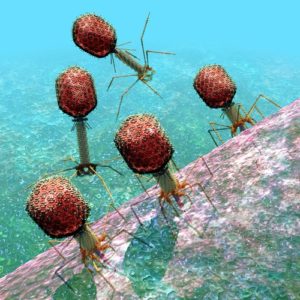
The complex intelligent battle between bacteria and the phage virus determines much of what occurs on the earth, these being the two most numerous life forms. Half of the ocean bacteria are killed each day in this battle; the White Cliffs of Dover, made of dead microbes, are a small remnant of the combat. Bacteria have developed a vast arsenal of weapons to survive being surrounded by thousands of phage virus at all times. Phage viruses, equally intelligent, have developed many counter moves. All of these weapons are based on stimulating, editing and manipulating genes to make new proteins with unique shapes. It is difficult to imagine how such complex large molecules that interact in extremely complex signaling pathways can be redesigned rapidly in warfare. These methods developed by bacteria and viruses have in many ways defined evolution. Here we describe some of the recently discovered intelligent virus tricks used for survival.
It is remarkable that virus and bacteria can rapidly create new genes and proteins that perfectly match shapes. The war between viruses and bacteria occurs by both sides stimulating, or altering, genes to make new proteins for attack and counter attack. The function of the protein depends upon its shape for lock and key interactions. Somehow, the virus knows what shape will occur when DNA codes are altered, which in turn alters linear sets of amino acids. (See posts for more information about problems relating to predicting protein folding and shape.)
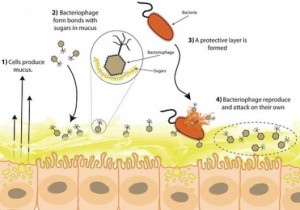 Previous posts have described how bacteria and phage virus can be either enemies, or very dependent friends. In fact, recent research demonstrates that viruses in the human mucosa form a barrier from enemy bacteria while aiding the local bacteria. These mucous viruses are critical for our innate immune system.
Previous posts have described how bacteria and phage virus can be either enemies, or very dependent friends. In fact, recent research demonstrates that viruses in the human mucosa form a barrier from enemy bacteria while aiding the local bacteria. These mucous viruses are critical for our innate immune system.
Most of the time phages outnumber bacteria ten to one (and in humans bacteria outnumber our cells ten to one). Bacteria use transfer of genetic material between comrades to thwart viruses. This material is transferred in a wide array of virus like particles (see post virus and virus like particles). At times, bacteria even manufacture their own viruses to send material. Bacteria fight phage by stopping them from attaching to the outer membrane, cutting virus genes, stopping their escape from the cell, and even killing themselves when infected to maintain the community.
Despite the many weapons used against viruses, a large number of bacteria lose the battle. Viruses use rapid targeted mutations, re arrangement of genes, and exchanges with other viruses to overcome ever changing bacterial weapons.
Attaching to Bacteria
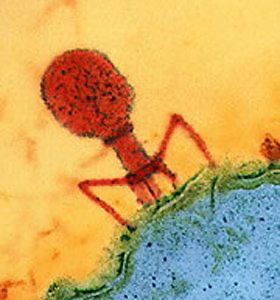 The phage virus must first attach to the surface of the bacteria and then inject (as a syringe) its DNA and other material. Much of the battle between virus and bacteria depends upon molecular shape recognition. Shape recognition is also the key to human immunity, to neuronal signaling and to molecular motors working in neurons. Bacteria have specific shapes of molecules on their membrane’s surface.
The phage virus must first attach to the surface of the bacteria and then inject (as a syringe) its DNA and other material. Much of the battle between virus and bacteria depends upon molecular shape recognition. Shape recognition is also the key to human immunity, to neuronal signaling and to molecular motors working in neurons. Bacteria have specific shapes of molecules on their membrane’s surface.
The phage receptor binding protein is a critical factor in this battle. Bacterial surface receptors include proteins, polysaccharides and lipopolysaccharides (LPS). How they are placed is critical for both sides.
Viruses are able to rapidly evolve and modify their receptor proteins. One phage, lambda, uses a particular receptor to bind to E.Coli bacteria, but when E. Coli has blocked that receptor, lambda evolved a second receptor so that it could attach at two different places at the same time. When the bacteria use either one of these receptors, the phage can operate. The virus needed four mutations, or edits, to accomplish this. Also, when bacteria completely change their receptor, the phage can evolve to recognize the new one. These mutations, or edits, occurred in either the receptor binding protein or the tail fibers of the virus.
The virus, also, can make a new enzyme to unmask a hidden receptor. When attacked by a new receptor from the virus, the bacteria modify their cell membrane. This tactic can hurt the bacteria, however, by limiting growth, and making themselves vulnerable to other different phages.
When a receptor is hidden from view of the virus with a capsule or other carbohydrate, the virus makes specific enzymes to break open the capsule. The genes used to make this new enzyme were originally for parts of the tail but degenerated/altered/edited to become a gene to make an enzyme. Phages can also acquire these enzymes from other viruses with genetic transfers. Some transfer particles can release their enzyme unattached to the virus and then break open the capsule for another virus
Multiple Devices for Changing Situations and Different Parts of Life Cycle
 If the virus response is only to a particular situation, for example, responding to an action of a bacteria signaling the bacterial colony, the usefulness of products are limited to that action.
If the virus response is only to a particular situation, for example, responding to an action of a bacteria signaling the bacterial colony, the usefulness of products are limited to that action.
In fact, viruses are able to make multiple proteins for the different phases of the bacterial life cycle. Remarkably, these predict future actions.
Viruses are able to make variable responses based upon particular timing of the growth phases of the bacteria. Viruses manufacture a variety of different receptor proteins that respond at different times. For example, specific enzymes are created that cannot attack a stationary bacteria, but only one that is growing rapidly. This is like betting. The virus creates a mixed variety of attacking enzymes that attack bacteria in different phases of their life cycle. Another example is when E. Coli phage makes four different tail fibers, which are affective against a wide range of different E.Coli and Salmonella bacteria.
The genes related to these receptors for tail fibers and membrane proteins are the fastest evolving genes in the virus.
After Entering the Cell
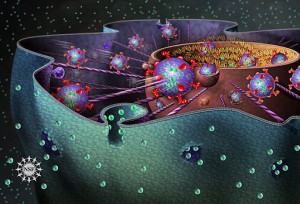 When a virus enters the cell, the bacteria have a wide range of attack methods as well as many physical barriers. One attack involves enzymes to cut the virus DNA at particular places, again, coded by pattern recognition. The bacteria, also, makes a second enzyme to protect its own DNA from the new cutting enzyme. There are a wide variety of techniques in this battle, both from the bacterial and the virus side.
When a virus enters the cell, the bacteria have a wide range of attack methods as well as many physical barriers. One attack involves enzymes to cut the virus DNA at particular places, again, coded by pattern recognition. The bacteria, also, makes a second enzyme to protect its own DNA from the new cutting enzyme. There are a wide variety of techniques in this battle, both from the bacterial and the virus side.
Places Where Virus DNA Can’t Be Cut
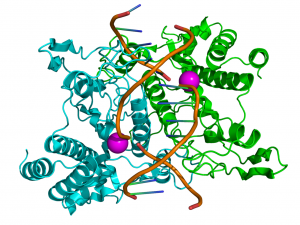 Some viruses have fewer places in the DNA where it can be cut, called restriction sites. Therefore, the bacterial enzymes have to be able to cut widely separated places on the virus DNA, or cut two places in a specific order, or in different orientation directions. Some viruses have restriction sites both in several places and several different orientations.
Some viruses have fewer places in the DNA where it can be cut, called restriction sites. Therefore, the bacterial enzymes have to be able to cut widely separated places on the virus DNA, or cut two places in a specific order, or in different orientation directions. Some viruses have restriction sites both in several places and several different orientations.
Some phage virus place modified unusual bases onto the DNA that can confuse bacterial enzymes. For example, one phage replaced thymine with hydroxymethyl uracil. Surprisingly, some bacteria have specific enzymes that can cut modified bases. In this case the T4 phage protected itself by 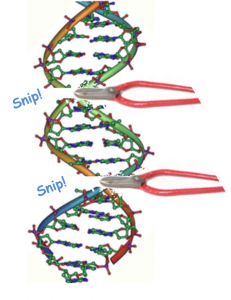 injecting a specific protein that bottles up the enzyme. In response, the E. Coli bacteria created several counter measures.
injecting a specific protein that bottles up the enzyme. In response, the E. Coli bacteria created several counter measures.
In another situation, the virus creates a mimic of the DNA that the bacterial enzyme is targeting. The mimic then surrounds the bacterial enzyme to stop it.
In another situation, the virus increased the activation of the second enzyme that protects both the bacterial DNA and in this case also the virus DNA.
Active Evasion Mechanisms
The phage virus also uses proactive techniques to avoid being cut by the bacterial enzymes. In one situation two different proteins are co injected along with the DNA in the bacteria. These proteins bind the virus DNA hiding its vulnerable restriction sites. This protein creates a mimic of the DNA itself taking up the enzyme that thinks it is DNA and not a protein.
Some viruses change their own DNA such as through methylation, the technique used in epigenetic changes in animals. Several viruses stimulate the host enzymes to increase protection.
Evading CRISPR – the Bacterial Immune System Against Jumping Genes and Viruses
 Bacterial cells developed a specific immune system to defend against random destructive DNA entering the cell. Clustered regularly interspaced short palindromic repeats, are known as CRISPR. It is used against jumping genes (jumping genes are pieces of DNA that move themselves – see post on jumping genes which make up 50% of humans DNA). Viruses are able to side step CRISPR using specific anti-CRISPR proteins.
Bacterial cells developed a specific immune system to defend against random destructive DNA entering the cell. Clustered regularly interspaced short palindromic repeats, are known as CRISPR. It is used against jumping genes (jumping genes are pieces of DNA that move themselves – see post on jumping genes which make up 50% of humans DNA). Viruses are able to side step CRISPR using specific anti-CRISPR proteins.
The way CRISPR works is by having many repeats of a DNA pattern separated by specific DNA taken from viruses or jumping genes. By comparing these patterns, when the virus DNA is recognized CRISPR’s complex machinery cuts it.
Phages can evade CRISPR by small mutations/edits that change recognition in CRISPR. The position of the mutation is critical for this to work. Some bacteria actively acquire new spacers from the virus they are fighting at the moment.
There are many different anti CRISPR genes, five found in one bacterium under attack. These were near the genes coding for capsids, which are virus covers. These genes make a protein that interferes with CRISPR surveillance complexes. The proteins either are injected into the cell, or are synthesized inside the cell.
Another tactic is that that the viruses create their own entire competing CRISPR system. Some of these are identical to the bacterial system. The two competing systems, then, send interfering molecules back and forth. Such viruses completely hijack the bacterial system, blocking it, while creating new virus and eventually killing the cell.
Bacteria Altruistic Suicide – Killing Virus and Itself
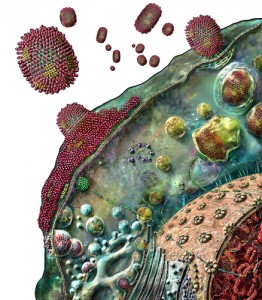
An altruistic technique of suicide by some bacteria allows comrades to survive while killing the virus and itself. In some cases virus are able to abort this self destruction to be able to continue to use the cell’s machinery. Bacteria usually receive these genetic killing systems from transfers; they live in the bacteria as free floating cellular DNA particles such as a prophages (a piece of a virus) or plasmids (free floating DNA that is transferred between bacteria – see post Virus and Virus Like particles in Evolution).
One system involves the bacteria making two different toxins, one that is stable and one that is not stable. When stress occurs, such as a viral infection, the antitoxic deteriorates and the toxin either kills the bacteria or makes it dormant.
Another system uses two proteins. The first senses the infection of virus and the second creates a hole in the membrane creating a loss of ATP energy in the cell. This stops the bacteria and also the virus. In one case the virus stopped the creation of the hole in the bacteria and took over the cell entirely.
Another system stops all translation of RNA into proteins. This leads to cell death and defeat of the virus.
Research into fermented dairy products has found 23 different systems where bacteria kill itself in the process of exterminating the virus infection. These involve many completely different mechanisms affecting the process of DNA, RNA and proteins production in the cells.
Some viruses sidestep elements of this process. They keep the bacteria alive by manufacturing a molecule that replaces the bacterial antitoxin function, thereby eliminating death of the cell and allowing the virus to continue.
Evading and Altering Microbe Machinery
Phages are incredibly efficient at using the bacterial cell to copy itself. But, if the bacteria mutate/edit its own machinery as part of the process, the virus can be defeated.
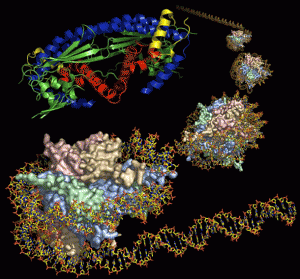 Phages overcome these changes in several ways. One protein inhibits the RNA polymerase of the bacteria by changing this critical enzyme’s shape, stopping transcription of DNA to RNA. The virus then uses its own RNA polymerase to continue making viruses.
Phages overcome these changes in several ways. One protein inhibits the RNA polymerase of the bacteria by changing this critical enzyme’s shape, stopping transcription of DNA to RNA. The virus then uses its own RNA polymerase to continue making viruses.
Another type of E. Coli bacteria has a slightly different RNA polymerase, which stops the virus molecule. Yet another modification by the virus allows the continued replication.
Viruses also can change other specific details in the process. Chaperone molecules, the very complex helper proteins needed to rapidly fold proteins (see post on Protein Folding), help both the bacteria and the new virus proteins. When the bacteria alters the chaperone molecule with a mutation/edit, the phage also changes its genes, altering the structure of their own assembly that works with the chaperone. This maneuver allows the virus to utilize the mutated chaperone molecule.
Another type of virus is able to withstand the alteration of the bacteria’s chaperone molecule by making its own parts for the chaperone molecule that then helps with the folding of the virus capsid.
It is very hard to understand how such complex mechanisms could occur without intelligent self editing. These very specific changes in the genetic code affect the three dimensional shape in large complex proteins.
Toxin Antitoxin During Virus Escape
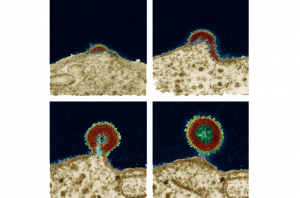 When the virus is ready to escape from the cell, bacteria manufacture many different toxins as well as their own antitoxins (to protect themselves) in a final attempt to kill the virus. In turn, viruses create antitoxins or a pseudo mimic of the antitoxin, which hijacks the host antitoxin. There are at least five different types of toxin-antitoxin systems. Some are directed only at specific types of phage and not others.
When the virus is ready to escape from the cell, bacteria manufacture many different toxins as well as their own antitoxins (to protect themselves) in a final attempt to kill the virus. In turn, viruses create antitoxins or a pseudo mimic of the antitoxin, which hijacks the host antitoxin. There are at least five different types of toxin-antitoxin systems. Some are directed only at specific types of phage and not others.
One bacterium makes enzymes that need to be neutralized by two different antitoxins. When viruses attack, protein synthesis stops, and antitoxin kills the cell. The T4 phage, can also make another antitoxin to stop the process, allowing the virus to continue multiplying.
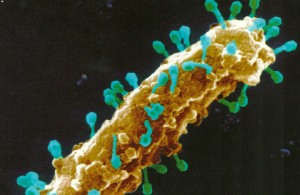 Another system uses RNA antitoxin that cuts RNA and kills the cell; another enzyme neutralizes it. A virus makes a similar molecule to the second neutralizing enzyme allowing virus reproduction to continue. Another phage hijacks the original bacterial enzyme allowing the virus to continue to multiply.
Another system uses RNA antitoxin that cuts RNA and kills the cell; another enzyme neutralizes it. A virus makes a similar molecule to the second neutralizing enzyme allowing virus reproduction to continue. Another phage hijacks the original bacterial enzyme allowing the virus to continue to multiply.
In this last example, the phage viruses were able to send to the genes of the entire antitoxin enzyme system to other virus to use in other bacteria.
New Virus Tricks to Survive
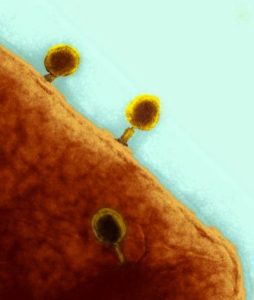 There are 1031 phage on the earth, that is, 10 with 31 zeroes after it. Phages and bacteria exist in every place on earth, including all man made spaces. Humans have ten trillion cells, with one trillion in the brain. Humans also house ten times as many bacteria and 100 times as many phage viruses.
There are 1031 phage on the earth, that is, 10 with 31 zeroes after it. Phages and bacteria exist in every place on earth, including all man made spaces. Humans have ten trillion cells, with one trillion in the brain. Humans also house ten times as many bacteria and 100 times as many phage viruses.
Surprisingly, virus and bacteria know when to cooperate such as in human mucous. But, for most situations a fierce intelligent battle rages. This battle is unusual in that is occurs when specific genes are stimulated, newly coded, or newly edited to make new proteins. The new proteins can, also, be produced by alternative RNA splicing. Somehow, the coding changes make the exact shapes that are needed for the battle, since it all occurs through shapes that attach through lock and key mechanisms. Since, it is becoming clear that cells self edit, (see post on cell’s self editing and intelligent T cells) it is very hard to understand this level of rapid self editing of very complex large proteins that need to be exact shapes.
Phages have a vast array of tactics to avoid barriers. The battle that occurs is a major driving force of evolution. Many techniques involve making new receptors, finding hidden receptors in bacteria, and recognition of variable timing of multiple receptors. There are many ways bacteria cut virus DNA and equally many ways that viruses avoid this cutting. The bacterial immune  system, CRISPR, against random pieces of DNA, viruses or jumping genes, is used against specific viruses. Bacteria can change the CRISPR setup in real time to fight a new virus. The bacteria’s last defense is attack by toxins, with the virus creating many different antitoxins.
system, CRISPR, against random pieces of DNA, viruses or jumping genes, is used against specific viruses. Bacteria can change the CRISPR setup in real time to fight a new virus. The bacteria’s last defense is attack by toxins, with the virus creating many different antitoxins.
The ingenuity of a virus, which is essentially a relatively small strand of DNA, is quite remarkable. In real time, both bacteria and virus can alter extremely complex molecules and systems. While modern science is unable to determine how an ordinary sized protein will fold from knowing the sequence of amino acids (including using the most advanced supercomputers), the virus does know. It is able to stimulate DNA editing, and focused mutations changing DNA code to arrive at these attacks and counter attacks.
Just as our antibody producing cells are able to focus and direct mutations, so are viruses. It is very hard to understand such a complex self editing process without cellular intelligence.